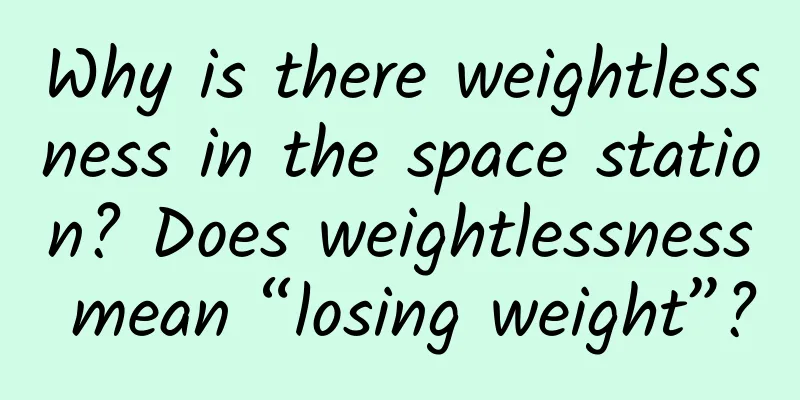Why is there weightlessness in the space station? Does weightlessness mean “losing weight”?

|
The astronauts' space lectures let us see many magical phenomena brought about by the microgravity environment in the space station. Microgravity environment means that the weight of an object is close to zero, which is what we often call a weightless environment. But why is there weightlessness in the space station? Let's expand this question a little bit. Why do spacecraft flying around the earth in orbit and the objects inside them lose weight? Astronauts in the Chinese space station (Photo source: China Manned Spaceflight Official Website) Let’s first look at some of the more popular misunderstandings: Misunderstanding 1: A spacecraft orbiting the earth is affected by both the earth's gravity and the centrifugal force caused by circular motion. The resultant force of the two forces is zero, so the spacecraft is weightless. Reason for error: Newton's first law tells us that an object will maintain uniform linear motion or remain stationary when there is no external force (including when the net force is zero). However, the spacecraft orbits the earth, so the above statement is not true. In fact, centrifugal force is a virtual force, not a real force. Without considering very small forces such as solar pressure, atmospheric drag, and the gravity of the moon, the spacecraft is only affected by one major force when orbiting, which is the gravity of the earth. Misunderstanding 2: The spacecraft is relatively far away from the earth and is subject to very little gravity from the earth, so it is weightless. Cause of error: Take the space station as an example. The space station is about 400 kilometers from the ground, and the gravity acceleration is about 89% of that on the ground. That is to say, the gravity of the earth that the space station and its internal objects are subject to at this orbital altitude is 89% of that on the ground. It is precisely because of this 89% of the earth's gravity that the space station will fly around the earth instead of leaving the earth and flying into deep space. So, why is there weightlessness in the space station? Weightlessness means that the support or pulling force on an object is less than the gravity of the object. Weight and gravity are two concepts. Gravity is only related to the acceleration of gravity. Theoretically, gravity remains unchanged at the same height of the earth. Weight can be simply understood as the force measured by a measuring tool (such as a scale), that is, the support force given by the scale to the measured object. When an object loses support, the weight becomes zero, which produces weightlessness. To give an example in life, when an elevator descends rapidly, we in the elevator will feel weightlessness for a short period of time. This is because when the elevator is stationary, the support force and gravity on the elevator and the people in the elevator are equal; when the elevator accelerates down, the support force on the elevator and the people in the elevator is less than gravity. If you stand on a scale and take an elevator, we can observe the change in weight as the elevator goes up and down. There are four most common methods for creating a microgravity environment: drop towers, airplanes, rockets, and spacecraft. The easiest to understand is the drop tower, which is to release an object from a high place to make it fall vertically and freely. During the free fall of an object, it is only affected by gravity, without any other supporting force or pulling force, and is therefore in a state of weightlessness. The drop tower at the University of Bremen in Germany is 146 meters high. In the "drop mode", the experimental system is released from a height of 120 meters, and the objects in the system can obtain 4.74 seconds of microgravity time; in the "ejection mode", the experimental system is ejected vertically to the top of the tower and then falls back freely, and the objects in the system can obtain up to 9.3 seconds of microgravity time. The Falling Tower of the University of Bremen, Germany (Photo source: ESA official website) The principle of a weightless aircraft is similar to the principle of the "ejection mode" of a drop tower. It obtains microgravity through parabolic flight. The trajectory is shown in the figure below. The aircraft engine will be turned off in the middle section. In the first half, it will rely on inertia to maintain the ascending state but the speed will gradually decrease. After reaching the top, it will accelerate to descend. That is, the aircraft is in a weightless state during the period of decelerating ascent and accelerating descent. At this time, the acceleration direction of the aircraft is downward, that is, the direction of the resultant force is downward, that is, the gravity is greater than the lift (the air's support for the aircraft), thus obtaining a weightless environment. Flight path of a weightless aircraft (Image source: Wikipedia) Similarly, the space station is weightless because it is only affected by gravity and has no other supporting force, and is actually in a state of falling toward the ground. This seems difficult to understand - the space station is obviously flying around the earth? The space station is indeed falling towards the ground, but the earth is spherical, and while the space station is falling back to the ground, the earth's horizon is also falling. After the space station reaches the first cosmic velocity, its falling speed is the same as the falling speed of the horizon, which means it will never fall back to the earth. Of course, this is a theoretical state. When the space station is in orbit, it will be affected by the gravity of the sun and the moon, the solar wind, atmospheric resistance, etc., causing the speed to continue to decrease and the orbital altitude to continue to decrease. Therefore, ground flight control personnel will regularly use engine propulsion to maintain its orbit so that the space station will not fall back to the earth. |
>>: How serious are the consequences if spies steal hybrid rice seeds in my country?
Recommend
Link Mobility released its 2017 Q4 and full-year financial report with a net profit of US$111.4 million in Q4
On April 11, 2018, Beijing time, Link Mobility (N...
APP Promotion Activities: How to plan a screen-sweeping event?
Wang Zaixing, co-founder of New World, said in an...
Writing information flow copy like this will increase the click rate by 12.8 times
When you are selling a summer camp course for an ...
Daguang's "KaKaKa Crazy Cashing Course" Five Douyin tracks for making money quietly
Training course content: The five major Douyin tr...
Top physicists will discuss the future of quantum at the birthplace of quantum mechanics
2025 was declared the "International Year of...
Yang Jingkun: "Play with short videos with your phone and shoot cool Vlogs with zero basics"
Yang Jingkun's resource introduction of "...
Drones are now popular, how can we develop them into large-scale commercial use?
The road to commercialization of drones: Is it re...
What is Encyclopedia Promotion? How to do Encyclopedia Promotion?
With the continuous development of the Internet, ...
Advertising and Marketing: A Century of Change
The COVID-19 pandemic that is raging around the w...
"Chinese people can't fly third-generation aircraft"? The 25th anniversary of the first flight of the J-10, the details behind it are revealed
March 23, 1998 When the J-10 completed its first ...
E-commerce people must learn 6.18: 6 advanced "hidden discount" operation routines
Just now, Ele.me took advantage of me. When it wa...
How was China's first castle in the air built?
Five Thousand Years of Chinese History We have bu...
How to acquire the first 1,000 high-quality seed users at low cost within one month?
You have no money, no resources, and you feel ove...
Google manufacturing is not "hard enough"
[[246149]] "I wonder who dares to say that t...









